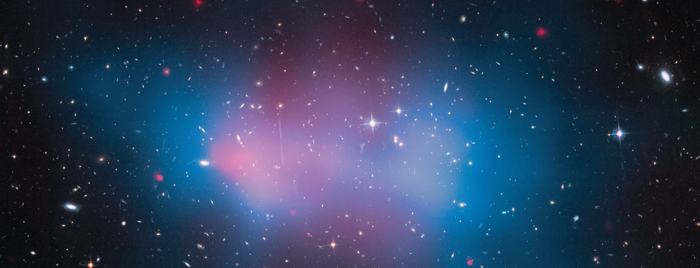To begin understanding dark matter in astrophysics, one must first step into a world where galaxies are considered small. The is the world that Annika Peter, Ph.D., and graduate student Stacy Kim are discovering more fully at The Ohio State University’s Center for Cosmology and AstroParticle Physics. Their research could better define the substance that comprises over a quarter of the universe.
While the particles that make up gases and stars are well known, scientists do not know what makes up dark matter – only that these are new, undefined particles. The dominant hypothesis is that dark matter is made up of weakly interacting massive particles, or WIMPs. However, there is some observational evidence that the hypothesis is not valid.
“The problem with [WIMPs] is that on scales that we consider small, which, to us, is the size of clusters of galaxies and smaller, it looks like things aren’t what they should be,” Kim said.
To better define its properties, astrophysicists look at how dark matter might interact with itself. Dark matter is gravitationally attractive and, by the WIMP theory, should settle into dense clumps. After observing the movement of stars within galaxies, researchers noticed that stars were not orbiting as quickly as they should if dark matter were stable, as the WIMP theory suggests.
Peter and Kim are exploring a model called self-interacting dark matter. To do this, they are researching the “stickiness” of dark matter – if dark matter particles can collide with each other. To test the theory of collisionality, Kim is virtually smashing galaxy clusters together through the use of the Ohio Supercomputer Center.
“The clusters that Stacy has been simulating are the biggest bound structures in the universe, and when they hit each other, it’s like the largest particle collider in the universe,” Peter said.
Kim observes how dark matter and galaxies move when two galaxy clusters with equal mass collide. By looking at the distribution of galaxies and dark matter after a collision, Kim may be able to determine how “sticky” dark matter is.
A detection of dark matter collisionality would upend the presiding WIMP paradigm and could begin to define the illusive properties of this mysterious particle.
“This is sort of the missing link that allows us to translate between theories of dark matter and what astronomers see in the sky,” Peter said.
Project Lead: Annika Peter, Ph.D., The Ohio State University
Research Title: Investigating the collisionality of dark matter with simulations of merging galaxy clusters
Funding Source: National Aeronautics and Space Administration
Website: physics.osu.edu/people/peter.33

